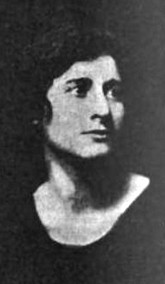Sara Mildred Strauss (September 1, 1896 – July 7, 1979) was an American dancer, educator, choreographer, and writer.
Early life
Strauss was born in 1896, in New York City, the daughter of Lehman Strauss and Pauline Cohn Strauss. In 1911, she and her mother, a noted horsewoman, drove a horse-drawn carriage 280 miles, across the state of New York, as a vacation.
Career
Dance, choreography, and dance education
Strauss established several dance schools, including programs at Carnegie Hall and New York's Ziegfeld Theatre, summer schools in Europe, and a studio in Hollywood. She taught at the American Academy of Dramatic Arts in New York. She was a friend to Russian filmmaker Sergei Eisenstein in New York.
With her company, the Sara Mildred Strauss Dancers, she gave a "novel and experimental" non-musical performance at New York's Guild Theatre in 1928. In 1930, she fought New York's Sunday observance law, which prevented dance performances on Sundays. She argued that her company's performances were not like theatre; "without the aid of music, pantomime, decor, costume or lighting", they were more like displays of visual art. In 1933 she held free public symposia on dance at her studio in Carnegie Hall, with invited speakers and informal themes.
Strauss created and directed choreography for her company, who appeared in Broadway shows, including the Ziegfeld Follies (1934), and Calling All Stars (1934), and in the musical film Sweet Surrender (1935). She also developed "Living Movement Figure Dolls", bendable mannequins for use in store windows and dance instruction.
Writing and other activities
As a young woman, Strauss wrote The Dance and Life (1916), her treatise on the centrality of dance to physical and mental well-being. "The ground of all human art is bodily motion," she explained. "Into bodily motion enters rhythm, which is the mind of the dance and the skeleton of tone." Here an Inch, There an Inch (1966) was her later book on similar themes. She also gave advice on health, fitness, and posture in newspaper columns.
In the 1920s, Strauss was active in junior auxiliary of the New York section of the National Council of Jewish Women.
Personal life
Sara Mildred Strauss married lawyer Isaac Bear Newman (1901-1981). She moved to Wilmington, North Carolina, late in life, and died there in 1979, aged 82 years. Her papers are in the Jerome Robbins Dance Collection at the New York Public Library. There is another collection of her papers at the William Madison Randall Library, University of North Carolina at Wilmington.
References
- "Home Matters". The Burlington Free Press. 1905-08-22. p. 10. Retrieved 2020-04-01 – via Newspapers.com.
- "Mother and Daughter Drive 280 Miles for Pleasure". The Frederick Post. 1911-09-20. p. 2. Retrieved 2020-04-01 – via Newspapers.com.
- "Sara Strauss Influenced by La Duncan". The Los Angeles Times. 1936-10-25. p. 59. Retrieved 2020-04-01 – via Newspapers.com.
- ^ Dimitriadou-Shuster, Aikaterini. "Sara Mildred Strauss papers". Jerome Robbins Dance Division, The New York Public Library for the Performing Arts. Retrieved 2020-04-01.
- Seton, Marie (1960). Sergei M. Eisenstein : a biography. Niles Essanay Silent Film Museum. Grove Press. pp. 242–243.
- "Stars in New Dance Technique". St. Louis Globe-Democrat. 1937-12-26. p. 67. Retrieved 2020-04-01 – via Newspapers.com.
- "STRAUSS DANCERS GIVE NON-MUSICAL PROGRAM: Recital, First of Its Kind in America, Deals With Story of Creation". The New York Times. April 30, 1928. p. 18 – via ProQuest.
- "SARA STRAUSS DANCES WITH AID OF COURT; Injunction Prevents Enforcement of Sunday Law--Nimura Also Performs". The New York Times. 1930-02-24. ISSN 0362-4331. Retrieved 2020-04-01.
- Martin, John (9 April 1933). "The Dance: A Symposium; Discussions Sponsored by Miss Strauss Proving of Value". The New York Times. p. X6 – via ProQuest.
- Dietz, Dan (2018-03-29). The Complete Book of 1930s Broadway Musicals. Rowman & Littlefield. pp. 305–306, 353–354. ISBN 978-1-5381-0277-0.
- "The Stage: Shubert Theatre, 'Calling All Stars'". The Boston Globe. 1934-11-22. p. 23. Retrieved 2020-04-01 – via Newspapers.com.
- Koszarski, Richard (2008-08-27). Hollywood on the Hudson: Film and Television in New York from Griffith to Sarnoff. Rutgers University Press. p. 279. ISBN 978-0-8135-4552-3.
- "Where Big Girls Play with Dolls". The San Francisco Examiner. 1943-01-31. p. 79. Retrieved 2020-04-01 – via Newspapers.com.
- "Revival of the Dance will Promote Musical Appreciation". Musical America. 29: 29. December 7, 1918.
- Strauss, Sara Mildred (1966). Here an inch--there an inch: instant figure beauty for the modern woman. Prentice-Hall.
- Lowman, Josephine (1951-01-01). "Why Grow Old?". Fort Worth Star-Telegram. p. 16. Retrieved 2020-04-01 – via Newspapers.com.
- "Social Events". The American Hebrew. 108: 395. February 11, 1921.
- ^ "MS199 Sara Mildred Strauss Newman". William Madison Randall Library, University of North Carolina at Wilmington. Retrieved 2020-04-01.
External links
- A cigarette card featuring a photograph of Sara Mildred Strauss dancing, from the Library of Congress.
- Sara Mildred Strauss at IMDb
- Sara Mildred Strauss at Find a Grave
- The "Appassionata Ballet" sequence from Sweet Surrender (1935), with the Sara Mildred Strauss Dancers, on YouTube.
